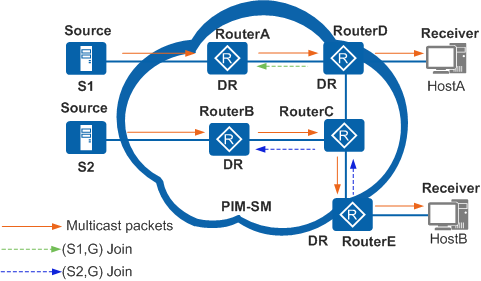PIM-SM (SSM Model)
Implementation
The SSM model uses IGMPv3/MLDv2 and PIM-SM technology. There is no need to maintain an RP, set up an RPT, or register a multicast source. An SPT can be built directly between the source and group members.
In the SSM model, user hosts know the locations of multicast sources before requesting multicast services. When user hosts join multicast groups, they can specify the sources from which they want to receive data. After receiving requests from user hosts, the receiver DR sends a Join message to the source DR. The Join message is then transmitted upstream hop by hop to set up an SPT between the source and group members.
In the SSM model, PIM-SM uses the neighbor discovery, DR election, and SPT setup mechanisms.
Neighbor Discovery
Neighbor discovery in PIM-SM is similar to that in PIM-DM. For details, see "PIM-DM Neighbor Discovery".
DR Election
DR election in PIM-SM (SSM model) is similar to that in PIM-SM (ASM model). For details, see "PIM-SM (ASM model) DR Election".
SPT Setup
Figure 1 shows the SPT setup process.
The SPT setup process is as follows:
- Using IGMPv3/MLDv2, RouterD and RouterE learn that packets from user hosts have the same multicast group address but are requesting multicast data from different source addresses. They send Join messages to sources hop by hop.
- PIM routers create (S1, G) and (S2, G) entries based on the Join messages and set up SPTs from S1 to HostA and from S2 to HostB.
- After SPTs are set up, the sources forward multicast packets along the SPTs to group members.
Comparison with the ASM Model
The major difference between the SSM and ASM models is that the SSM model allows hosts to specify multicast sources and the ASM does not. Table 1 gives more detail about the differences between the two models.
| Protocol | Model | Usage Scenario | Implementation |
|---|---|---|---|
| Protocol Independent Multicast - Dense Mode (PIM-DM) | ASM model | Small-scale LANs where multicast group members are distributed densely | Using the flood-prune mechanism, PIM-DM creates and maintains a unidirectional and loop-free SPT connecting a multicast source and group members. |
| Protocol Independent Multicast - Sparse Mode (PIM-SM) | ASM model | Large-scale network where multicast group members are distributed sparsely | An MDT is set up when receivers join a multicast group. PIM-SM needs to maintain an RP, set up an RPT, and register a multicast source. |
| SSM model | Scenarios where user hosts know the exact locations of multicast sources in advance and can specify the sources from which they want to receive data before they join multicast groups | PIM-SSM does not need to maintain an RP, set up an RPT, or register a multicast source. |
